Posted by Anita on 09.28.07 7:11 AM
 The folks at The Spirit World sure picked a doozy for the inaugural episode of their “Raiders of the Lost Cocktail” challenge. I spent many evenings thumbing through my bar library, searching for recipes featuring Liquore Strega, and found precisely one mention of this saffron-tinted herbal liqueur.
The folks at The Spirit World sure picked a doozy for the inaugural episode of their “Raiders of the Lost Cocktail” challenge. I spent many evenings thumbing through my bar library, searching for recipes featuring Liquore Strega, and found precisely one mention of this saffron-tinted herbal liqueur.
Excitement quickly turned to despair as I noted the drink’s name: The Strega-nator.
Oh, please. Spirits snob that I am, I didn’t give it so much as a second glance. There’s no way in hell I am making a drink called the Strega-nator, much less putting it on the blog. I’d never be able to show my face at Mixology Monday again! I headed back to the drawing board, muttering under my breath about slapped-together cocktails with frat-boy names, cursing the editors who foist them on their unsuspecting readers.
Next, I hit the public library. Even among dozens of titles both old and new, I didn’t uncover many options. My curiosity was piqued, though, by a UK-published book that suggested mixing Strega with Orange Smash Squash. I consulted our City’s guru of British comestibles, who promptly dashed my hopes again. Orange Squash was nothing short of “putrid” said Sam: “I wouldn’t trust anyone who suggests you put it in a cocktail.” (After having personally sampled it — I found a bottle in the British foods section at Mollie Stone’s — I’m inclined to agree. It’s something like the bastard stepchild of SunnyD and Hi-C Orange, neither of which has any place in my kitchen, much less my bar.)
Once you’ve sunk to the depths of imported kiddie-colored juice substitutes, there’s nowhere to go but up. Having all the necessary ingredients on hand, I grudgingly gave the Strega-nator a whirl. And damned if it wasn’t tasty. Especially considering that it has no base liquor as its spine, it’s a fine drink. Well-balanced, nuanced, perhaps a tad sweet for my taste, but the herbal finish is quite bewitching. After much hand-wringing, I came to the realization that we’d all lived through one Drink of the Week with a god-awful name; why not make it a pair?
Unfortunately, I can’t imagine that a cocktail recipe published 18 months ago could really be considered “lost” for the purposes of the challenge. (Unless, of course, everyone else took one look at the name and flipped right past it, too — a distinct possibility.) I’ve got a few tricks up my sleeve, plus a full bottle of Strega and enough time before the challenge ends; there just might be another entry in the works.
As Arnold would say: “I’ll be back.”
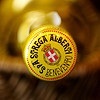




Strega-nator
– published in Food & Wine Cocktails 2006
credited to BLT Prime, New York City
2 oz Strega
1 oz fresh orange juice
1 oz fresh lime juice
2 oz chilled club soda
1 orange wedge, for garnish
Fill a cocktail shaker with ice. Add the Strega and juices, and shake well. Strain into an ice-filled rocks glass, and top with club soda. Garnish with the orange wedge.
cookbooks, Drink of the Week, drinks, other blogs
11 Comments »




Posted by Anita on 09.27.07 8:04 PM
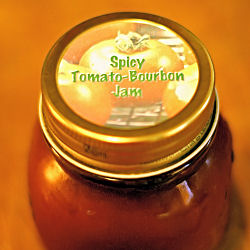 Making your own preserves may not exactly be the world’s simplest kitchen task. But if you limit yourself to a relatively small batch, and pick the right recipe — preferably one that avoids the canning process altogether — it can be a lot of fun. A lot more enjoyable than say, the back-breaking labor and knuckle-biting stress of processing 100 pounds of San Marzano tomatoes. (Details on that soon… promise.)
Making your own preserves may not exactly be the world’s simplest kitchen task. But if you limit yourself to a relatively small batch, and pick the right recipe — preferably one that avoids the canning process altogether — it can be a lot of fun. A lot more enjoyable than say, the back-breaking labor and knuckle-biting stress of processing 100 pounds of San Marzano tomatoes. (Details on that soon… promise.)
Tomato jam may seem like an odd beast, but it’s really not too far removed from ketchup. My favorite use for this spicy-savory preserve is spread liberally onto good Acme white bread, topped with Fatted Calf bacon and a wedge of Will’s avocado — a sort of post-summer BLT substitute. (We served tea-sized versions of these exact sandwiches at our housewarming party, and they disappeared faster than I could assemble them.) The jam also makes a glorious glaze for meatloaf, a dipping sauce for empanadas… really, the possibilities seem endless.
If you want to simplify even further, omit the seeding and straining. It won’t hurt the flavor of the final product, and it shaves another 15 or 20 minutes off your prep. Myself, I prefer the seedless version. But then, I am all about gilding the lily.
Need more bright ideas for preserving summer’s veggie bounty? Over at The Passionate Cook, Johanna’s hosting this month’s edition of “Waiter, there’s something in my…. [Savoury Preserves]”. Check back here in a few days for a link to the roundup in the comments.
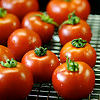


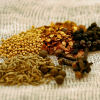

Spicy Tomato-Bourbon Jam
3/4 cup sugar
3/4 cup bourbon
3/4 cup cider vinegar
3 pounds tomatoes (preferably dry farmed)
1 tsp black peppercorns
8 whole allspice berries
8 whole cloves
1 tsp red-pepper flakes
1/2 tsp mustard seeds
1/2 tsp whole cumin seeds
Combine the vinegar, sugar, and bourbon in a glass or ceramic bowl. Stir to dissolve sugar, then set aside.
Prepare an ice-bath. Stem the tomatoes, but do not score them or remove their cores. Working in batches, blanch the tomatoes in boiling water until their skins start to split — a step beyond what you’d normally do if you wanted the tomatoes to stay firm. The timing will depend on each tomato’s size and ripeness, so keep tongs or a slotted spoon handy to check them regularly. As soon as each tomato splits, remove it and plunge into ice water. Peel off tomato skins and discard.
Make a spice sachet by placing all of the spices in the center of a square of cheesecloth and tying into a bundle with a piece of kitchen string.
Set a wide-mesh strainer over a medium bowl. Pull open each tomato gently, and use your fingers to remove the seeds and seed jelly from each pocket, letting them fall into the strainer. Place the seeded tomato pulp onto a cutting board set over a rimmed cookie sheet.
When all tomatoes are seeded, rough-chop them and place them in a large saucepan along with any juices from the cutting board. Add the vinegar-sugar-bourbon mixture and the spice sachet, and bring to a boil. Do not leave unattended, as the mixture will greatly expand as it comes to a boil.
 Using a spatula or wooden spoon, push the liquid surrounding the seeds through the strainer as much as possible. (This is where much of the flavor hides, so don’t stint here.) When you’re left with a dryish mass of seeds, discard them and add the liquid in the bowl to the saucepan, along with any puree on the underside of the strainer.
Using a spatula or wooden spoon, push the liquid surrounding the seeds through the strainer as much as possible. (This is where much of the flavor hides, so don’t stint here.) When you’re left with a dryish mass of seeds, discard them and add the liquid in the bowl to the saucepan, along with any puree on the underside of the strainer.
Reduce the heat to medium and, stirring occasionally, cook the tomato mixture 45 minutes or until it reaches a jammy consistency. Discard spice bag and divide tomato jam among sterilized jars or transfer to a container with tight-fitting lid. Let cool on countertop, then refrigerate until ready to use.
Note: Because this jam is not processed for storage, it must remain refrigerated. It will keep for about a month, provided you use a clean spoon every time.
farmers markets, locavore, other blogs, preserving & infusing, recipes
6 Comments »




Posted by Cameron on 09.21.07 7:07 AM
 “The history of the world, my sweet;
“The history of the world, my sweet;
Is who gets eaten and who gets to eat.”
— Sweeney Todd
We’re headed to the thyuh-tuh tonight for a performance of “Sweeney Todd: The Demon Barber of Fleet Street.” Here’s the short version: Crazy barber kills people, crazy restaurateur bakes them into meat pies, hilarity ensues.
I’ve loved the show since I first heard the music as an impressionable youth. How can you not like a musical with a showstopping number that muses about how different people would taste if you served them wrapped a tender, flaky crust?
While you digest that macabre notion, here’s a little something to wash it down. We’ve tinkered with the recipe a tad, but the name and the basic ingredients are original.





Sweeney’s Cocktail
1 1/2 oz brandy
1/2 oz pineapple juice
1/8 oz Maraschino liqueur (or to taste)
1/4 to 1/8 oz lemon juice
3 dashes Angostura bitters
Shake all ingredients well with ice. Strain into a chilled cocktail glass. Garnish with lemon twist, if desired.
Drink of the Week, drinks, literary, recipes
12 Comments »




Posted by Anita on 09.19.07 11:58 AM
 Back in May, I talked about the Thai cooking classes offered by Kasma Loha-unchit in her Oakland home, and mentioned that “Kasma’s classes, especially the beginning series, are perennially booked”. But if you get a wiggle on, you might be able to score a place in her 2008 classes, which were announced today.
Back in May, I talked about the Thai cooking classes offered by Kasma Loha-unchit in her Oakland home, and mentioned that “Kasma’s classes, especially the beginning series, are perennially booked”. But if you get a wiggle on, you might be able to score a place in her 2008 classes, which were announced today.
Seven sets of the four-class Beginning series, which costs $170, will be offered next spring:
March: Mondays, March 3, 10, 17 & 24
Tuesdays, March 4, 11, 18 & 25
Wednesdays, March 5, 12, 19 & 26
April: Mondays, March 31 & April 7, 14 & 21
May: Tuesdays, May 6, 13, 20 & 27
Thursdays May 8, 15, 22 & 29
June: Mondays, June 2, 9, 16 & 23
There’s more information, including menus, online at Kasma’s site, although the 2008 dates are not yet listed. You can send a request to hold your space to kasma[at]earthlink[dot]net; Kasma’s husband Michael recommends that you send along second- and third-choice series the first time around, as classes really do fill up quickly.
Good luck!
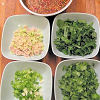

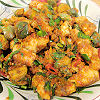
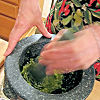

classes, East Bay, Thai
4 Comments »




Posted by Cameron on 09.19.07 11:49 AM
 Like we needed more herbs.
Like we needed more herbs.
Seriously, we’ve got thyme, rosemary, and oregano in the yard (and by the yard), probably the three most useful fresh herbs to have within easy clipping distance. Adding to that could be viewed as extravagance, piling on, perhaps even hubris. So why do we have a window box outside our breakfast room sprouting green leaves and stalks?
It all started in July with a bunch of sweet basil that Anita brought home from the farmer’s market. She used what she needed and stuck the rest in a glass of water on the kitchen windowsill, where we ignored it for two weeks. We must have added water at regular intervals, because the glass wasn’t all that big, but I don’t remember doing it or seeing Anita do it. It got less attention than a bald white guy at a dim sum parlor.
Darned if that bunch of basil didn’t grow roots and stay all green and lush and everything.
So about the time that we’re watching these stalks get their groove on in about a cup and a half of Hetch Hetchy’s finest, we start thinking that the view out the window of our breakfast room is a little stark. Which is not exactly a penetrating observation given that the window faces an expanse of painted plywood about eight feet away. This was also right about the time when the main garden was popping along in full summer bloom, and I was thinking that maybe I could see a faint tinge of green around the edges of my thumbs. Yes, even after I washed them. Smartass.
Anyway, I figured that if we gave this little survivor of a basil plant some dirt and a little love, we’d really see something. At the same time, a window box would be just the thing to spruce up the view. So I split the bunch of basil in two and planted half down in the yard near the bergamot tree. The other half I put in a window box along with some tarragon, chives, and Thai basil.
So far, the box has succeeded both as a still life and a food source. A little bit of the tarragon goes a long way, but it gave the sauteed potatoes that we made for our Julia Child dinner just the right touch. The chives have made cameo appearances in several dishes (including those same potatoes), and the Thai basil dropped in on one of our standby stir-fries last week.
The basil is still growing, but slowly; it’s a living demonstration of how my enthusiasm for gardening occasionally outstrips any calculations of practicality. As I’ve discovered, basil isn’t generally the sort of thing that you just pick a leaf or three off now and again. If you’re serious about consumption, you grow it in big bunches for regular harvest.
But honestly? I really don’t care. I know that I’ll have to plot (heh heh) and plan if I want to try a real vegetable garden… even a small one. In the meantime, it’s a thrill just to plant something green and watch it thrive. It feels like a promise that I’m making to myself.


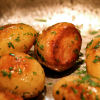
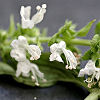

Pommes de Terre Sautées
adapted from Mastering the Art of French Cooking
2 pounds “boiling” or new potatoes
2 T butter plus 1 T oil, for sauteeing
2 to 3 T softened butter
1/4 tsp salt
2 to 3 T minced fresh green herbs (parsley, chives, tarragon)
Peel the potatoes. As you do, try and make them as smooth as possible and give them an oval shape that may remind you of extremely large olives or impossibly small rugby balls, depending on how you spent your formative years. Do not wash the potatoes after peeling; pat them dry with a clean towel. If you need to hold the raw potatoes for a while before you cook them, wrap them in a damp towel, and then dry them before cooking.
Add the butter and oil to a skillet and heat it over medium high. When the butter stops foaming, put the potatoes in and leave them for two minutes. Control the heat so that the butter/oil mixture stays hot but does not color. Shake the potatoes in the skillet, rolling them around and letting them sit to sear until they are pale gold all over.
Sprinkle the salt over the potatoes, lower the heat, cover the skillet, and cook the potatoes for 15 minutes, shaking them every three or four minutes to prevent sticking. When the potatoes yield to slight pressure from your finger or when a knife pierces them easily, use the skillet cover to hold in the potatoes while you pour off the fat.
Take the potatoes off the heat, add the softened butter, herbs, and a few grinds of fresh black pepper. Shake the potatoes in the skillet so that they glisten with herbs and butter. Serve immediately.
cookbooks, garden, recipes
4 Comments »




Posted by Anita on 09.14.07 7:05 AM
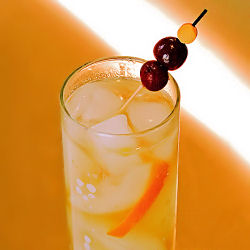 The year is 1895. In a Bordeaux village, brothers Paul and Raymond Lillet begin commercial production of a Sauternes-based elixir known as Kina Lillet. A bittersweet concoction steeped with cinchona and citrus, Lillet quickly becomes popular enough to spawn imitators, leading to an advertising campaign that encourages consumers to “avoid knock-offs.” The aperitif was (and is) often served with a citrus twist, sometimes along with ice and/or sparkling water.
The year is 1895. In a Bordeaux village, brothers Paul and Raymond Lillet begin commercial production of a Sauternes-based elixir known as Kina Lillet. A bittersweet concoction steeped with cinchona and citrus, Lillet quickly becomes popular enough to spawn imitators, leading to an advertising campaign that encourages consumers to “avoid knock-offs.” The aperitif was (and is) often served with a citrus twist, sometimes along with ice and/or sparkling water.
The same year, across the Atlantic, a gentleman by the name of George Kappeler publishes a book called Modern American Drinks, and for the first time in print describes an old-fashioned cocktail:
“Dissolve a small lump of sugar with a little water in a whiskey-glass; add two dashes Angostura bitters, a small piece ice, a piece lemon-peel, one jigger whiskey. Mix with small bar-spoon and serve…”
Fast-forward to 2007: Cocktail purists cry out against the modern practice of befouling an otherwise respectable Old Fashioned with a shot of soda water. Some highly orthodox practitioners even go so far as to ban the presence of muddled orange, advocating a return to the absolute original. I wish I had a dollar for every time I’ve heard a cocktail geek declare the Old Fashioned their litmus test of a bartender’s skill, their canary in a cocktail coal-mine. Even the merest splash of fizz is enough to send them running out the door, or at least huddling behind the safety of the beer list.
I’m with these libational Luddites, at least most of the way. But I find a touch — not a hearty glug — of soda a pleasant lightening agent in an Old Fashioned. Omitting the orange seems a tad austere for my palate; even the otherwise old-school DrinkBoy admits that the citrus adds “some useful and interesting flavors”. Rye is my whiskey preference here, but I will not deny a well-made bourbon variation, or even scotch in a pinch. In the realm of cocktail snobbery, I’m not quite Orthodox. I’m also a fan of tinkering with tradition, of using the classics as a springboard for modern variations.
So imagine my amusement with this entry on the drinks list at Downtown, a popular pre-theater stop across the bay in Berkeley:
Fashionably Lillet: Sugar cube, a slice of orange, brandied cherry & a dash of bitters muddled together with Lillet, served tall and cool with soda.
Hey there, that’s a clever hybrid of the continental Lillet & Soda and the all-american Old Fashioned. I’ve got no way of knowing if the bartender was poking good-natured fun at the soda-scoffing set, but the name alone tells us she’s got a sense of humor.
Amused at the idea, I order one up. Alas, the pint-glass concoction I’m served falls a bit short of the mark. Lillet’s a fairly mellow aperitif, after all, and even with plenty of ice, 16 ounces of headroom means the drink ends up tasting like lightly flavored soda water. It’s also unwieldy, so much so that the straw isn’t just a clever summery touch, but a necessity. And then there’s all that muddled fruit in the glass, which gums up the straw.
Back at home, we fiddle with the ingredients and try to come up with a solution. We futz with proportions, with glassware, with preparation methods, and with ratios, all without success. We set the recipe aside, and go about our summer.
This month’s Mixology Monday theme — Fizz, hosted by Gabriel at cocktailnerd — seemed like a good excuse to take another pass. While reading up on Old Fashioned history, a line in Robert Hess’s highly opinionated recipe post catches my eye:
“…the maraschino cherry doesn’t really add anything at this [muddling] stage besides a mangled carcass and a little bit of extra sugar…”
Hmm. He’s onto something there. The next time through, I leave out the cherry, saving it for garnish. The resulting drink is better, but still fairly weak. Adding more Lillet — the natural route to a stronger cocktail — makes the drink one-dimensional; the aperitif’s mildness, in this case, is no asset.
Suddenly, the solution becomes obvious: It’s a riff on an Old Fashioned, after all — why not a splash of rye? (Bourbon could work, but I’m trying to keep the sweetness in check.) It may have taken all summer, but I’m happy with the final mix: A light, summery cooler with a nod to both sides of The Pond.
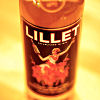
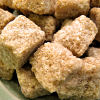
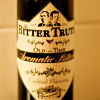


Fashionably Lillet
– adapted from Downtown
 1 cube natural sugar
1 cube natural sugar
1 orange slice, halved (divided use)
3 dashes aromatic bitters
1/2 oz rye or bourbon
2-1/2 oz Lillet blanc
3 oz soda water
brandied cherries, for garnish
Fill a highball glass with ice, arranging half of the orange slice among the cubes; set aside. In a mixing glass, muddle the sugar, half of the orange slice, and bitters together. Add the rye and the Lillet, and top with ice. Stir until well chilled, then strain into the prepared highball. Top with soda, and garnish with brandied cherries.
Drink of the Week, drinks, Mixology Monday, recipes
12 Comments »




Posted by Anita on 09.11.07 9:43 PM
 When a friend sends you home from a dinner party with a grocery bag full of her surplus fruit, there’s bound to be a bowl of pears you can’t quite devour before they get too ripe. This fact remains true no matter how many salads, croustades, soups, canapes, or batches of ice cream you make. Pear butter makes good use of these softies, of course, but there’s only so much toast — and so many hostess-gift occasions — in a year.
When a friend sends you home from a dinner party with a grocery bag full of her surplus fruit, there’s bound to be a bowl of pears you can’t quite devour before they get too ripe. This fact remains true no matter how many salads, croustades, soups, canapes, or batches of ice cream you make. Pear butter makes good use of these softies, of course, but there’s only so much toast — and so many hostess-gift occasions — in a year.
Preserving fruit in liquor is a time-honored way of extending its shelf life; we’ve made brandied plums many times. They’re incredibly simple to make, and they’re fabulous served warm alongside good vanilla ice cream, or baked in a boozy clafoutis. But here’s the dirty little secret: When all is said and done, the steeping liquid might even be better than the plums themselves.
One of my favorite fruit liqueurs is a pear cognac called Belle de Brillet, a spicy-sweet nip of autumn in a glass. It’s lovely all on its own, and it makes a glorious addition to Champagne (with or without candied-ginger vodka). So deep is my affection for the Belle, and so cher its pricetag, I have to ration my doses; if I sipped to my heart’s content, we’d be in the poorhouse by year’s end.
You see where all this is going, clever reader?
My homemade, locavore pear brandy is one of those “so-simple-there’s-no-recipe” recipes: Cut your ripe pears in half, and remove the core. Chop the unpeeled fruit into large chunks, and put them into a scrupulously clean glass or ceramic container. Top with a decent brandy — Korbel‘s based in Guerneville, if you’re keeping things close to home — and let sit, covered, for 3 or 4 days.
At the end of the steeping period, drain the brandy through a colander into a scrupulously clean glass or ceramic bowl; contrary to your frugal desires, do not press on the pears to release more juice. (If you absolutely cannot resist, press them into a separate container and drink this cloudy stuff first.)
Filter the drained brandy through successive layers of cheesecloth (one layer first, two layers the next time, etc) until the mixture looks reasonably clear. Clean out your steeping jar — scrupulously, of course — and store the filtered liquid in it. Refrigerate, resisting the urge to pick up the jar and peek at it, at least overnight.
After resting the infusion, ladle the liquid through a coffee filter set into a small sieve; I complicate things by placing the filter + sieve contraption on top of a metal funnel, and draining everything directly into a large storage bottle. You may prefer to keep things simple by first straining into a bowl. (You know what kind and how clean, right?) You’ll probably want to change filters at the end of each funnel-full of brandy; the microscopic pieces of pear that you’re removing will clog the filter and slow process considerably if you re-use the filters, especially as you get to the bottom of your jar, where the sediment has collected. The more times you filter, the longer the brandy will last before developing ‘off’ flavors. I always re-filter when making smaller gift-sized bottles.
Once you get the brandy filtered, taste your final product. I found my batch to be quite drinkable right out of the bottle, but Cookie’s pears were so ripe we had to cover them with a towel to keep the fruit flies at bay. If you prefer something sweeter, feel free to add simple syrup, agave syrup, or honey to taste.
I don’t usually store my infusions in the refrigerator — alcohol acts as its own preservative — but pear brandy goes south more quickly than other fruit liqueurs. Unlike limoncello that will last virtually unchanged for a year or more, pear brandy experiences a noticeable loss of flavor by the third day. It will be delicious for weeks and drinkable for months, but it loses its evanescent crispness by the end of the first week. Enjoy it (or, better yet, share it) right away.



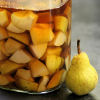

drinks, locavore, other blogs, preserving & infusing
12 Comments »




Posted by Anita on 09.10.07 1:04 PM
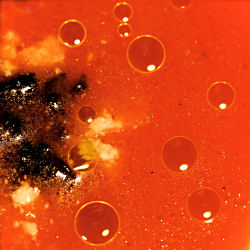 It’s been a gazpacho-filled summer for us. In addition to the traditional Spanish soup’s regular appearances on our warm-weather menus, we kicked off tomato season with Cookie’s gloriously deconstructed version, and were lucky enough to sample Sean’s gorgeous white Andalucian gazpacho, too.
It’s been a gazpacho-filled summer for us. In addition to the traditional Spanish soup’s regular appearances on our warm-weather menus, we kicked off tomato season with Cookie’s gloriously deconstructed version, and were lucky enough to sample Sean’s gorgeous white Andalucian gazpacho, too.
Now, I love me a straight-ahead gazpacho as much as the next tomato fanatic — that magical combination of cucumber, pepper, tomato, and vinegar is nearly unbeatable when it’s too hot to cook. But with two show-stopping variations fresh in my mind, I craved something equally appealing for Tami’s second Super Soup Challenge.
Rummaging through my library copy of Mitchell Davis’s Kitchen Sense, I spied a likely candidate. Much like the watermelon salad we brought to DPaul’s party last month, this fruit-based gazpacho is actually a savory appetizer, not a dessert. But it’s still easy as pie.
After rough-chopping all the veggies — all of which are in season and readily available from local farmers markets — you simply whiz them all together with a few simple seasonings, strain out any remaining bits, and chill for an hour in the fridge. At serving time, a pair of salty garnishes teams up with your best olive oil to add a touch of contrast. Drizzling the olive oil off the edge of a spoon gives the sparkle of beautiful small droplets.
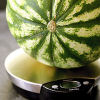
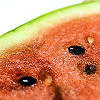
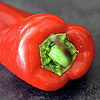
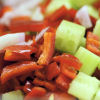

Watermelon Gazpacho
– adapted from Kitchen Sense
1 6-pound ‘icebox’ watermelon, red-fleshed
2 Kirby cucumbers or 1 hothouse cucumber, peeled (seeded, if necessary) and chopped
1 fresno chile or other medium-hot red chile, chopped
1/4 large red pepper, cored, seeded, and chopped
1/2 medium red onion, chopped
2/3 cup tomato juice
1/4 extra-virgin olive oil
1/4 cup sherry vinegar
1/2 tsp kosher salt
fresh-ground black pepper
—–
2 oz feta cheese, crumbled
3 T finely chopped Kalamata olives
your best olive oil, for drizzling
Remove the rind from the watermelon. Cut the flesh into chunks and remove the seeds, if necessary; you should have about 6 cups of melon. Using a stick blender, traditional blender, or food processor, blend all soup ingredients (except the garnishes) until well liquified — about 1 to 2 minutes. Strain the puree through a large-mesh strainer to remove any lingering seeds or other bits, pushing the pulp through with a spatula. Adjust seasonings as needed, and chill for at least an hour. Serve garnished with the feta and olives, and a drizzle of olive oil.
Serves 6 as an appetizer
cookbooks, cooking, farmers markets, locavore, other blogs, recipes
10 Comments »




Posted by Cameron on 09.07.07 7:13 AM
 We spend a fair bit of time thinking about fun things to put in cocktail glasses. We like filling them ourselves, and we like finding places where they arrive before us brimming with tantalizing, aromatic mixtures. But while we’ve written about liquors, liqueurs, bitters, and more, we’ve yet to address water, an indispensible part of an enjoyable cocktail experience.
We spend a fair bit of time thinking about fun things to put in cocktail glasses. We like filling them ourselves, and we like finding places where they arrive before us brimming with tantalizing, aromatic mixtures. But while we’ve written about liquors, liqueurs, bitters, and more, we’ve yet to address water, an indispensible part of an enjoyable cocktail experience.
We think about water in very different ways than we used to. It’s easy to forget that not long ago (when Lionel Ritchie danced on the ceiling), Evian and Perrier were truly snooty stuff. Today, even the most benighted grocery store offers multiple brands of still and sparkling water.
Bottled water is often more readily available than tap, and it occasionally solves real issues of quality or sanitation. Anita’s mom lives just outside of Las Vegas, where she buys drinking water by the five-gallon jug at one of the area’s ubiquitous water stores. (Yep, that’s all they sell.) We’re glad that she does, as the local tap water laughs at Brita filters and tastes like it came from an ill-kept swimming pool.
But many geographic regions have seriously good tap water, and local water is even an irreplaceable recipe ingredient. In these areas, bottled water provides convenience or a perception of higher quality, but comes with with a true pricetag we’re just starting to appreciate. Why, when we’re counting our food-miles, watching our carbon footprint, and supporting area farmers by buying local meat and vegetables, are we washing it all down with water that has been shipped from Europe? This question has prompted several Bay Area restaurants to switch from bottled water to municipal water that they refilter — and sometimes even carbonate — themselves.
Carbonation, of course, generates that delightful addition that you can’t get from the tap: bubbles. The carbonation machines used in restaurants are large and expensive — out of reach of most private citizens. But supplying your maison with local eau gazeuse is achievable. If you live in or near a city, you may be within range of a service like the Seltzer Sisters, which jacks up good old Hetch Hetchy with fizz and delivers it in reusable plastic seltzer bottles. If you have a hardcore DIY streak, you can find surprisingly detailed plans for building your own carbonation system. Or, you can buy a soda siphon and charge your own seltzer. (In the interests of full disclosure, our own siphon adventures have been less than successful; your mileage, as they say, may vary.)
No matter where it comes from or how it got there, water can make or break a single cocktail or an evening’s indulgence. Soda water is a common mixer, and ice cools and tames a drink’s ardent spirits — some even feel strongly about the very shape and clarity of the ice that does the job.
But for all that, the water that we appreciate most when we’re at a bar is stuff that arrives alongside our cocktails. Presuming that it doesn’t taste like a Vegas swimming pool, our requirements are simple: water should be available immediately and continually. We do our level best to drink at least one full glass for each cocktail. Providing ample water is one of the surest signs of a thoughtful bartender; staying hydrated is the best way we know of to avoid a painful sunrise.





Dressed-up Tap Water
Even if your area enjoys pleasant-tasting tap water, a quick preparation before your next dinner party can add a bit of grace to your table. Fill a pitcher with water and put it in the refrigerator to chill. An hour or so before your guests arrive, float a few slices of citrus or cucumber in the water to give it a little extra flavor. You can leave the citrus slices in the pitcher when you serve, but it’s best to pull the cucumber out, as it can become waterlogged and unattractive.
bar culture, Drink of the Week, drinks, entertaining, locavore
8 Comments »




Posted by Anita on 09.06.07 12:02 PM
 Sure, sure… we’ve all heard the swooning coming from the assembled masses lining up outside Bi-Rite Creamery. (And yes, we’re in awe of their salt-caramel ice cream, just like everyone else.) But waaayyyy down at the other end of The Mission, there’s another ice-cream shop that’s packing them in every night, just like they have since the kids in line sported white bobby socks and greased hair.
Sure, sure… we’ve all heard the swooning coming from the assembled masses lining up outside Bi-Rite Creamery. (And yes, we’re in awe of their salt-caramel ice cream, just like everyone else.) But waaayyyy down at the other end of The Mission, there’s another ice-cream shop that’s packing them in every night, just like they have since the kids in line sported white bobby socks and greased hair.
Although the days when Mitchell’s used milk from its own dairy farm are long gone, each flavor is still made on the premises in small-batch freezers. More than 50 state-fair ribbons and medals on the wall tell the story of the family’s commitment to quality.
You won’t find any honey-lavender or soy-chai scoops here, but that doesn’t mean that Mitchell’s doesn’t get its gourmet groove on. The shop’s biggest claim to fame may be its roster of tropical flavors, sporting tongue-twister names like langka, macapuno, and lucuma, alongside a longer list of ‘standard’ (but still interesting) tastes. Reading the menu’s like a trip around the globe: Thai tea, Mexican chocolate, and New York Cherry are just three options. Feeling cocktailian? Rum raisin, Kahlua, and mojito might do the trick. A set of flavors rotates seasonally; peach holds court today, but pumpkin can’t be far off.
Go ahead, take a number. You’ve got plenty of time to decide…




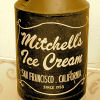
Mitchell’s Ice Cream
688 San Jose Avenue (at 29th)
San Francisco, CA 94110
415 648-2300
dessert, locavore, shopping, The Mission
9 Comments »




 The folks at The Spirit World sure picked a doozy for the inaugural episode of their “Raiders of the Lost Cocktail” challenge. I spent many evenings thumbing through my bar library, searching for recipes featuring Liquore Strega, and found precisely one mention of this saffron-tinted herbal liqueur.
The folks at The Spirit World sure picked a doozy for the inaugural episode of their “Raiders of the Lost Cocktail” challenge. I spent many evenings thumbing through my bar library, searching for recipes featuring Liquore Strega, and found precisely one mention of this saffron-tinted herbal liqueur.



























 Like we needed more herbs.
Like we needed more herbs.










 1 cube natural sugar
1 cube natural sugar





 It’s been a gazpacho-filled summer for us. In addition to the traditional Spanish soup’s regular appearances on our warm-weather menus, we kicked off tomato season with Cookie’s gloriously
It’s been a gazpacho-filled summer for us. In addition to the traditional Spanish soup’s regular appearances on our warm-weather menus, we kicked off tomato season with Cookie’s gloriously 










 Sure, sure… we’ve all heard the
Sure, sure… we’ve all heard the 



